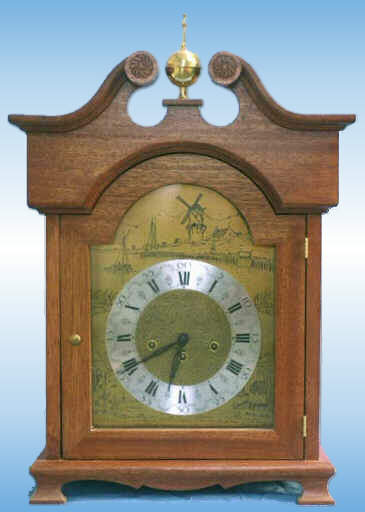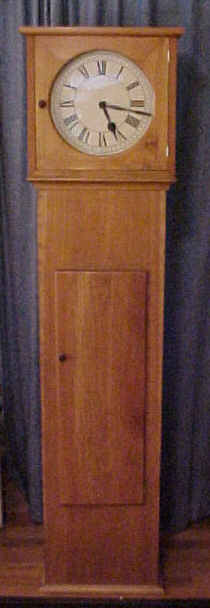Many companies offer some thing like a "walnut finish" on their clocks, likely a dark stain applied on a lesser grade of wood. Not here. All but one of the wood components of the clock case are made with solid wood (walnut, cherry, oak, mahogany and pine), precisely milled and fitted. The only exception being the dial panel, a plywood veneered in the same type of wood, is used for the sake of stability. The dial panel is 1/4 inch thick and solid wood this thin is likely to contract and expand with seasonal changes. The plywood panel is much more stable and contraction and expansion are virtually eliminated. The one side of the plywood is veneered with the same wood type as the rest of the clock. All clocks are finished with a hand-rubbed paste varnish.
I use a keywound movement in each clock, unless a quartz movement is requested. These movements are made by the Hermle company in Gosheim, Germany, respected for many years as the largest producer and market leader of mechanical clock movements. The former family business of Franz Hermle & Sohn was founded in 1922 and is well-known for making precision clock movements that are made to last for many, many years, guaranteeing many generations of precision time keeping. The only exception to the Hermle keywound movements is the Kieninger 9 bell triple chime movement, placed in the Grandfather Mantle Clock.
Keywound movements need to be wound once a week and "overwinding" a clock is a pervasive myth. It is impossible to overwind a clock. Simply turn the key until it will no longer turn. The mainspring is as tightly wound as its going to get and it can not be wound any tighter. I would like accomodate people who find winding a clock once a week an inconvenience, therefore I offer them a clock with a quartz movement. These movements still contain actual chime rods and hammers, just as the keywound movements.
I use metal dials, brass pendulums, brass hinges and the finest hardware. I cut no corners in my craft; in short, I am striving to make the finest clocks available today.
There are a number of clocks here on the website but I do accept custom orders. Please let me know if there is something in particular you are looking for. A photo is very helpful, I can usually size up the dimensions from it. I have a knowledge of Hermle movements but as a whole, I do not repair clocks.
 |
 |
 |
 |
 |
An explanation about the clock chimes:
A Bim-Bam strike is two notes in quick succession. The clock chimes a set of two notes for each hour and once on the half hour.
Bim-Bam with chime rods: three hammers strike chime rods.
Bim-Bam with bells: hammers strike two bells.
Gong: a hammer strikes a coiled gong, once for each hour and once on the half hour.
Westminster Chime: 5 hammers strike chimes on each quarter hour, count out the hours.
Triple Chime: 8 hammers strike chimes on each quarter hour, count out the hours. Westminster, Whittington or St. Michaels Chimes.